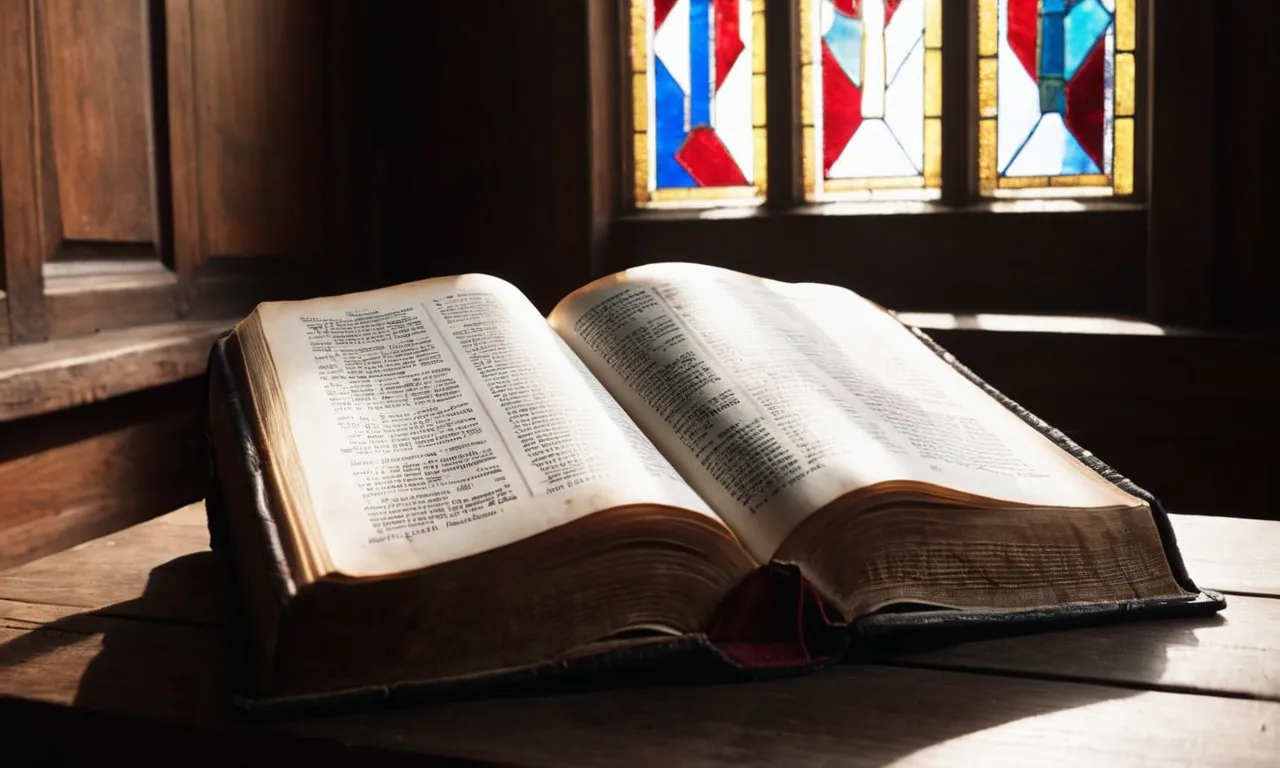What Does Sacred Mean In The Bible?
The concept of the sacred is central to understanding the Bible and its teachings. But what exactly does ‘sacred’ mean in a biblical context? Simply put, sacred refers to someone or something set apart and dedicated to God for holy use and purpose.
If you’re short on time, here’s a quick answer: In the Bible, sacred describes people, objects, places, and even time periods that are set apart and dedicated to God for holy purposes.
In this comprehensive article, we will explore the multilayered meaning of sacred in Scripture, examining key Hebrew and Greek words, analyzing how sacredness applies to things, people, places, and events, and reflecting on the theological significance of sacredness and holiness in the biblical narrative.
The Hebrew Concept of Sacred: qodesh
Basic Meaning and Usage of qodesh
The Hebrew word qodesh refers to something that is “set apart” or “separated from common use.” In the Bible, it often denotes objects, places, times, and people that are sacred and dedicated to God. The root meaning has to do with being distinct, different, other than normal.
In the Old Testament, qodesh applies to things and people connected to worship and the temple. For example, sacred objects like the ark of the covenant, altar, priestly garments, temple furnishings, and sacrifices are called qodesh (Exodus 28:38; 29:37; 30:25).
The temples, tabernacle, and sanctuaries are referred to as the qodesh place (Exodus 26:33). The Sabbath day is called qodesh (Exodus 20:8).
The priests and Levites had special qodesh status as they were set apart and consecrated for service to God in the tabernacle and temple (Exodus 29:1; Leviticus 21:6-7). Even the camp of Israel had sacred zones – the area around the tabernacle was sanctified and off-limits to lay people (Numbers 1:53).
Sacred Objects and Sacred Space
The Hebrew understanding was that anything qodesh was inviolable and off-limits for common use. Sacred objects were not to be treated like ordinary utensils. They required special care and could impart holiness – or impurity – to those who came in contact with them (Haggai 2:11-13).
In a similar way, sacred space was not to be treated as ordinary ground. God told Moses to remove his sandals when standing on holy ground (Exodus 3:5). Sacred areas like the inner sanctuary of the temple were restricted only to priests (Leviticus 16:2).
Even holy land itself could be violated or profaned by sin and idolatry (Jeremiah 2:7; Ezekiel 36:17-18).
At the heart of these distinctions was the understanding that anything connected to God’s presence was holy, separate, and distinct. Common things were not to be confused or mixed with what was sacred.
Sacred People and Set Apart Status
Not only objects and places, but certain people had special qodesh status. As mentioned, the priests and Levites were set apart and consecrated for tabernacle service. Their lives were marked by unique regulations, sacrifices, and purification rituals (Leviticus 21-22).
In an even greater sense, the Jewish nation as a whole was called to be a holy qodesh people as God’s special treasure and witness to the world (Exodus 19:5-6; Deuteronomy 7:6). Laws like Sabbath-keeping, dietary restrictions, and moral codes set Israel apart from other nations.
Yet the goal was not just legal separation, but actual devotion and service to God. As a “kingdom of priests” they were called to reflect God’s character to the nations (Exodus 19:6; Leviticus 19:2). So qodesh status implied a weighty responsibility. They were set apart for God’s purposes.
The Greek Concept of Sacred: hagios
Meaning and Usage of hagios
The Greek word hagios is central to understanding the biblical concept of sacred. It is translated as “holy” or “sacred” and conveys the idea of something set apart and distinct from the common or profane.
In ancient Greek culture, objects, places or people deemed hagios were treated with reverence and awe. Temples were viewed as the dwelling places of the gods and were thus considered sacred spaces. The oracle precincts, like the one at Delphi devoted to Apollo, were set apart as hallowed ground.
Distinguishing Between Clean and Unclean
The ancient Israelites incorporated aspects of hagios into their theology. They made strong distinctions between what was ritually clean (tahor) and unclean (tameh). Things declared sacred by God were tahor, while activities like touching corpse contamination or skin diseases were deemed tameh.
In the Torah, God calls the Israelites to be holy as He is holy (Leviticus 11:44-45). Holiness meant following God’s commands for ritual purity and avoiding pagan practices. His holy tabernacle was consecrated with blood to distinguish it as sacred space.
Being Set Apart for God’s Purposes
The New Testament builds on these ideas. Followers of Jesus are called saints or “holy ones” (Romans 1:7), set apart by God for his purposes just as temple utensils were consecrated for worship. Believers’ very bodies become sacred space, the dwelling place of God’s Spirit (1 Cor 6:19-20).
As modern readers explore biblical texts, gaining insight into the concept of hagios sheds light on what it means for people and things to be deemed sacred. It involves awe-inspiring otherness and being specifically designated to serve the purposes of the Divine.
Key Examples of the Sacred in Scripture
The Temple and Tabernacle
The Temple in Jerusalem was considered the most sacred place for the Israelites. Built according to instructions given by God to Moses on Mount Sinai, the Temple housed the Ark of the Covenant and was the dwelling place of God’s presence on earth (Exodus 25-27).
Only the High Priest could enter the Holy of Holies, the innermost sanctuary of the Temple where the Ark resided. The rituals and sacrifices performed at the Temple gave it great religious significance.
Before the Temple stood the Tabernacle, a portable tent shrine used by the Israelites from the time of the Exodus until the building of the Temple by Solomon. Like the Temple, the Tabernacle was constructed based on divine instructions and contained the Ark of the Covenant (Exodus 35-40).
As the precursor to the Temple, the Tabernacle was also a sacred place where God dwelled among His people.
Sacred Vestments and Objects
Certain objects associated with worship and the Temple were considered sacred in ancient Israelite religion. These included the ephod worn by the High Priest, which had precious stones representing the 12 tribes engraved on it (Exodus 28).
The Urim and Thummim were sacred lots used by the High Priest to discern God’s will (Exodus 28:30). The Ark of the Covenant was a gold-plated wooden chest containing the stone tablets of the Ten Commandments and was seen as the earthly throne of God (Exodus 25:10-22).
Sacred anointing oil was used to consecrate the Tabernacle, High Priest, and sacred objects (Exodus 30:22-33). The altar of incense was central to worship rituals (Exodus 30:1-10). These and other objects connected to worship rituals had sacred status.
Sabbaths and Appointed Times
Certain times were also sacred under the Mosaic Law. The Sabbath day (Saturday) was holy and set apart for rest and worship (Exodus 20:8-11). There were also sacred festivals and feasts, like Passover, Pentecost, and the Day of Atonement, that were set times for celebration, sacrifice, and reflection on God’s providence (Leviticus 23).
The sabbatical year that came every seven years was set apart as sacred, with its requirement to let the land rest from cultivation (Leviticus 25:1-7). The Jubilee year that followed seven cycles of sabbatical years was also sacred as a time of community restoration.
By setting apart particular times and days, the Israelites recognized the sacredness of time given by God.
Sacred Covenants and Vows
Covenants and vows had a sacred status in the Bible. God’s covenants with Noah, Abraham, Moses, David, and others established sacred bonds and promises (Genesis 9:8-17, Genesis 15, Exodus 19-24, 2 Samuel 7).
The Ten Commandments were considered the sacred stipulations of the Mosaic covenant (Exodus 20). Nazirite vows to set someone apart for sacred service to God were binding commitments with spiritual significance (Numbers 6:1-21).
Vows made to God had to be fulfilled due to their sacred nature (Numbers 30:2). Covenants and vows that invoked God’s name carried weight as sacred pacts.
Theological Significance of Sacredness
Reflecting God’s Holiness
The Bible teaches that God alone is inherently sacred and holy (Isaiah 6:3). His very nature is completely pure, righteous, and set apart from all creation. Therefore, anything designated as “sacred” in Scripture reflects the holy character of God Himself.
Sacred places, objects, and rituals all symbolize the greatness of the Lord and inspire awe and reverence for Him.
For example, the tabernacle and temple were considered sacred because God’s presence resided there (Exodus 40:34-35). The furnishings inside the temple were sacred as they were dedicated to the Lord for worship and sacrifice.
Even the clothing worn by the priests was sacred as they ministered before the Lord (Exodus 28:2).
Requiring Proper Reverence
Because sacred things are associated with God’s holy presence, they must be treated with solemn respect and utmost care. The Bible warns that mishandling sacred objects or violating sacred spaces will result in God’s judgment (2 Samuel 6:6-7).
Sacred rituals also must be performed according to His instructions.
God harshly punished Belshazzar when he desecrated the holy articles from the temple by using them for drinking at a pagan feast (Daniel 5:3-4). When the Ark of the Covenant was being transported improperly on an ox cart, the Lord’s anger burned against Uzzah and he struck him down when he touched the ark (2 Samuel 6:6-7).
These sobering accounts remind us to handle the holy things of God with reverence.
Symbolizing Dedication to Divine Purposes
When people or objects are consecrated as sacred in the Bible, it signifies their special dedication to service for the Lord and His kingdom. Sacred people include priests, prophets, the firstborn, and the Levites. Their lives were devoted to worship, prayer, temple service, and other holy duties.
Sacrificial offerings and temple furnishings were also sanctified, set apart exclusively for worshipping Yahweh. The sabbath day was declared holy and meant for resting in the Lord (Exodus 20:8). Even the temple mount and the ground around the burning bush were considered sacred after God’s presence dwelled there (Exodus 3:5).
Therefore, biblical sacredness not only reflects God’s holiness but also marks things as specially designated to carry out His will and purposes.
Conclusion
In examining the multilayered biblical meaning of sacred, we have explored key Hebrew and Greek terms, seen how sacredness applies to objects, people, places, and time, and reflected on the theological significance of setting apart and dedication to the Lord.
Ultimately, the sacred points to the ‘otherness’ and perfection of God’s holiness. By understanding sacredness, we can grasp Scripture’s teachings about reverencing God’s presence, accessing his grace, and aligning ourselves with his purposes for creation.








